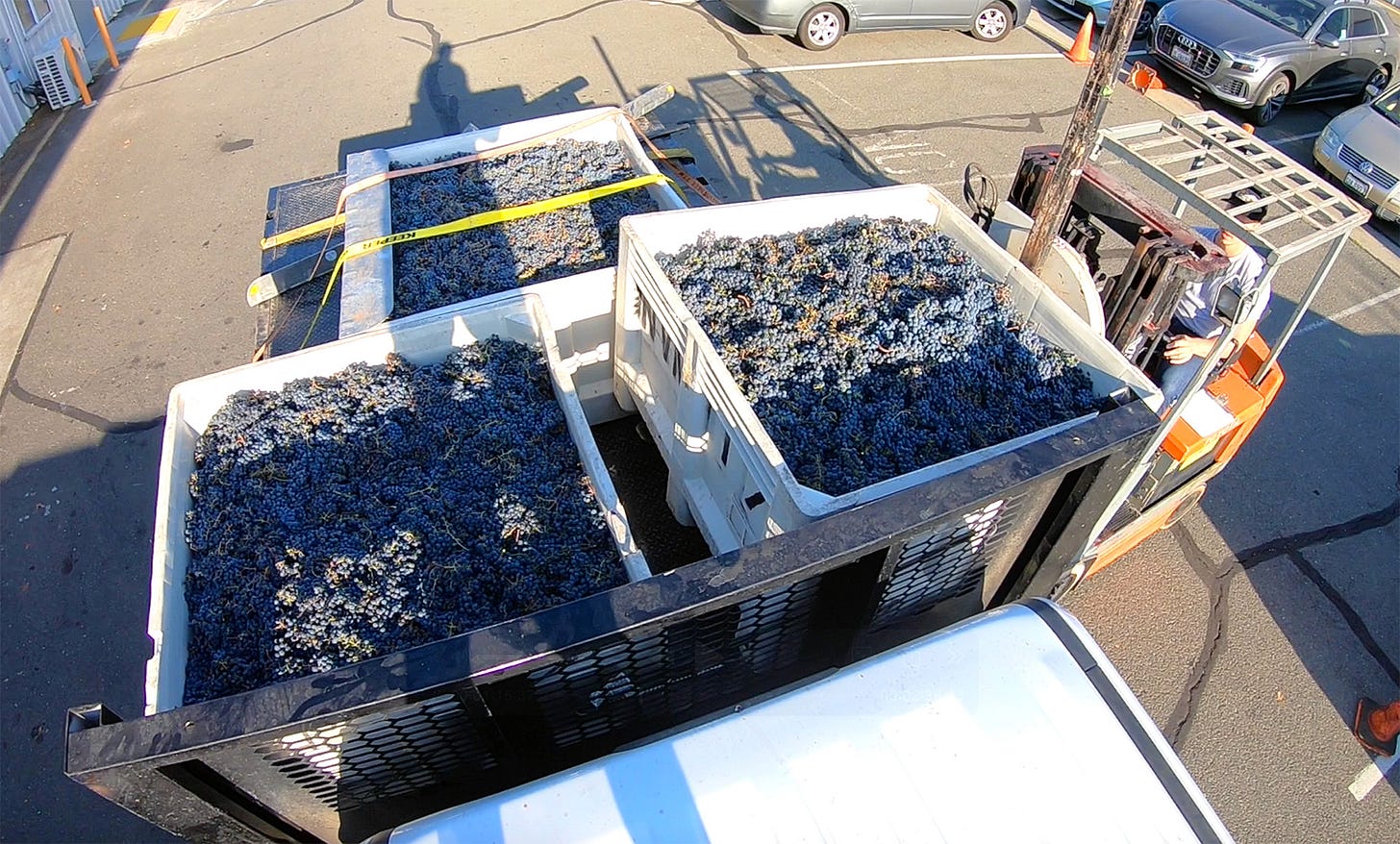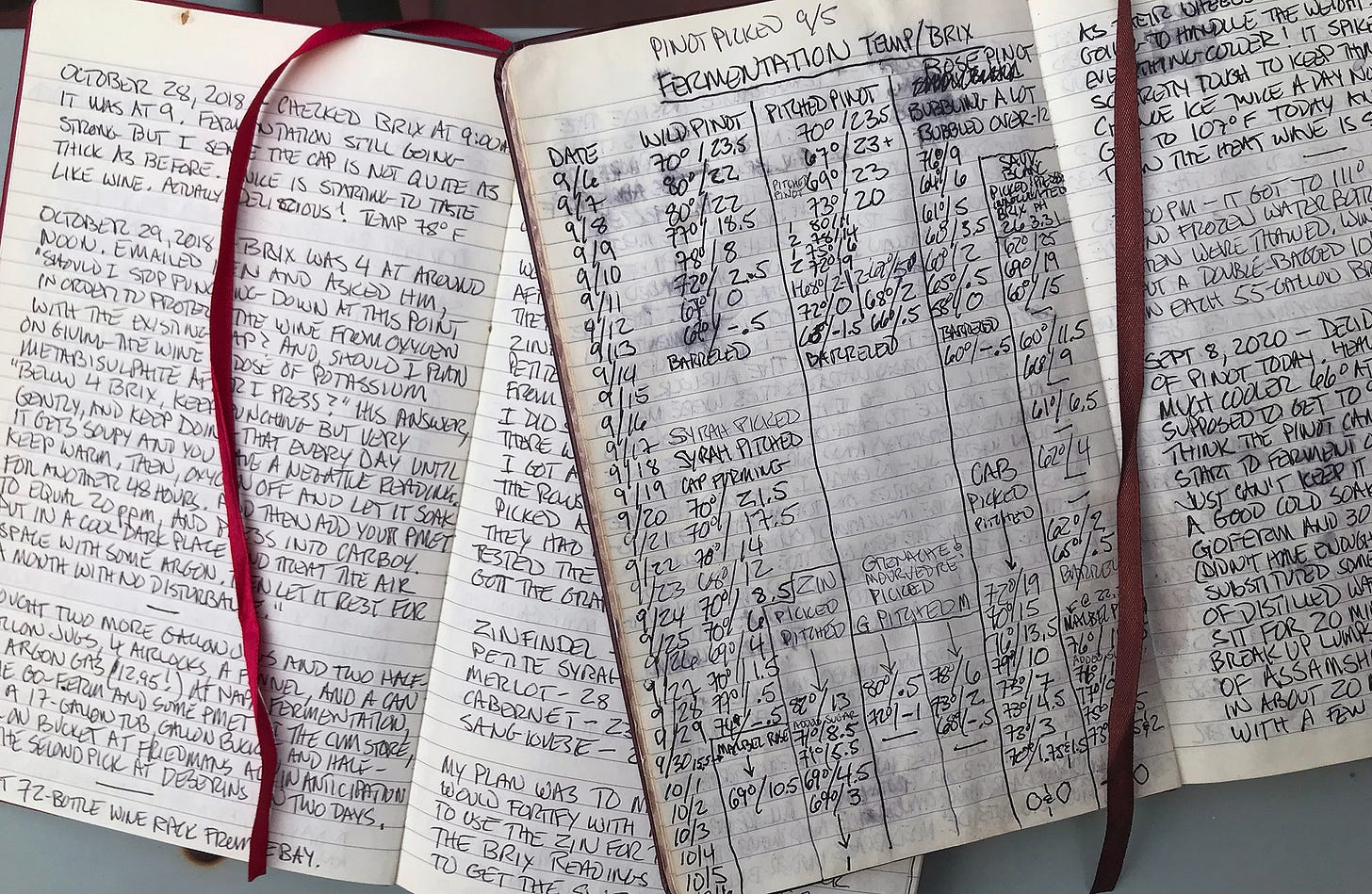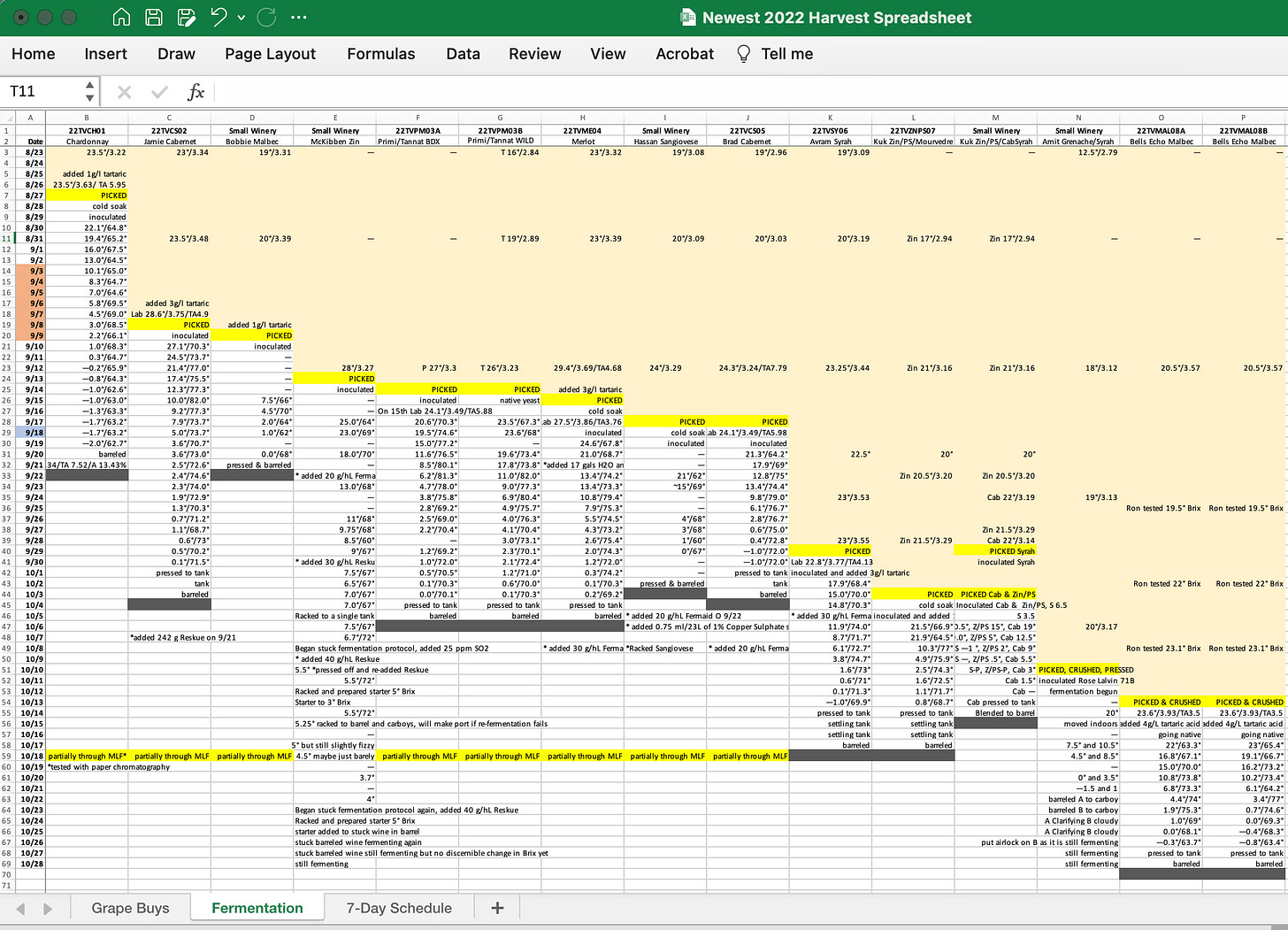People who keep journals have life twice. – Jessamyn West
The global economy is built on two things: the internal combustion engine and Microsoft Excel. Never forget this. — Kevin Hector
In my first four years of winegrowing—i.e., the joint pursuits of tending vineyards, harvesting grapes and making wine—I kept a detailed journal of each harvest season and subsequent winemaking. I love doing this journaling, and having a detailed diary of each year has proven invaluable as I hone my skills.
Almost two years ago I also started this newsletter, and last year I even did a daily posting of harvest happenings on Instagram for over 30 days in a row during the height of the season. But heck, last year I only harvested around 4.5 tons of grapes and made about 800 gallons of wine between my little backyard winery and Magnolia, my commercial custom crush. That was too small to even qualify me as a “micro-winery.” So, all the journaling about winegrowing still seemed as important—if not more so—than the actual winemaking itself.
This year, however, is a different story. I harvested over 11.5 tons of grapes and I’m making about 1,860 gallons of wine—call it 780 cases. What with keeping track of ever-changing harvest schedules and logistics, finding folks to help pick, taking regular grape samples for Brix/pH measurements as different vineyards ripened, and then dealing with all the fermentation analytics and adjustments once the grapes were crushed, it was just too much detail to carefully jot down in my Hemingway-esque leather-bound diary each night, along with witty notes and observations.
And, quite frankly, this year I had no energy at the end of the day for what at times felt like a self-indulgent ritual. More often than not I had to be up before dawn the next morning for the next pick or press, and sleep was at a premium. So I did what I’ve always done when a project demands ongoing attention to detail. I tossed my ultra-fine-point Sharpie into the pencil jar and crossed over to the dark side into the Kingdom of Excel, where I created a basic spreadsheet that I could populate with mundane but essential data.
Did I miss the storytelling, the late-night wine-induced wordplay? Well, sure. But I missed sleep more.
Still, I’ll be the first to admit that making wine is much different than making other kinds of consumer products, or manufacturing cars, or publishing books. It can’t be fully or easily translated onto a spreadsheet. No place there for nuance.
Winemaking begins as farming in its purest sense—growing a basic crop like corn, or soybeans, or wheat—but with the added influences and challenges of varietal clones and rootstocks, terroir, vineyard architecture and orientation, microclimates, water tables and degrees of sunlight.
The thing about making wine is that it relies on Mother Nature to a far greater extent than most other agriculture. And Mother Nature is fickle—and she’s awful pissed off right now. Thankfully we were spared wildfires for the second year in a row. But the grand old green gal threw down a few thunderbolts in the forms of continued drought, heat domes (WTF?!), and a sudden deluge. Those in turn disrupted my carefully laid plans on several occasions.
This was a challenging harvest season. Not too many winemakers will tell you different. There was certainly a time or two when I wondered if I was really up to the constantly changing and often confusing conditions. Was I just a well-schooled, fair-weather oenophile with no grape grime under my fingernails, or could I pivot and make the crucial, real-time decisions needed to save the day in the vineyard and on the cellar floor?
I guess I was about to find out.
One thing was clear. I was responsible for my own destiny this year, with quite a bit of money on the line, and, as I saw it, the entire future of the Tiny Vineyards Wine Company at stake. Fortunately, I had my recently indoctrinated business partner, Bruce, and my heart partner, Deb, as sounding boards. Not a whole lot of winemaking knowledge between those two, but both were extremely quick studies with enough moxie to spur me on, gently apply the brakes if necessary, and talk me off the ledge when I started to doubt myself.
To paraphrase Nietzsche (who was set to music by the indomitable country, pop, rock, R&B and gospel singer, Grammy Award winner, and inaugural American Idol champion Kelly Clarkson): “What doesn’t kill you makes you stronger.”
That’s kind of how I felt this season. I dodged a few bullets, got handed my ass once or twice, but overall I emerged with a heightened level of confidence. It was a lot of hard get-your-hands-dirty-and-your-muscles-sore kind of work, but genuinely rewarding. Good juice, as I’m fond of saying—a labor of the land, invigorating, intoxicating, and just enough scary every now and then.
To bring it back full circle to journaling—winemaking IS all about the details, and the details tell the story. So the story should be shared. And, since I seem to be borrowing from everyone, there’s also that old saw about a photograph being worth beaucoup words. You don’t see too many photos embedded in an Excel spreadsheet.
I had mapped out a precise plan for the types and tonnage of grapes I wanted to harvest in 2022, and the wines I wanted to make. I intended to follow it religiously. I was also committed to earning the $100-a-ton discount that Magnolia was offering to any winemakers who processed more than 10 tons of fruit. The only thing I hadn’t accounted for was the unpredictable nature of… well… nature. As Woody Allen once said, “You want to make God laugh, tell him your plans.”
Here’s how it all really went down this year.
August 27 - Chardonnay harvest for commercial wine
Picked 1,600 pounds of Chardonnay in lieu of the ton I had been promised. The yield on the small vineyard I had contracted with was way down, bees were attacking the fruit, the vineyard owner had over-sold allotments, and had also somehow forgotten our original purchase-price agreement. Then, on top of everything else, I ended up overpaying him because I figured the amount due without first subtracting the tare weight of the picking bins. Sheesh!
September 1 - Change of plans #1
I was forced to cancel a one-ton harvest of Grenache because many of the grapes were suffering from some kind of heat damage and their skins were crusting over and cracking. This was a big bummer, as I had planned on these grapes as one of the components of a GSM Blend (Grenache, Syrah, Mourvedre) that I had won an award with as an amateur winemaker and really wanted to make commercially this year.
I’d hardly even started my harvest season and already I was 1.2 tons short on my planned tonnage. Plus I now had to figure out what to do with the extra Syrah and Mourvedre I was still contracted to pick even if I couldn’t make the GSM.
Not exactly an auspicious or professional start to the season!
September 8 - Cabernet Sauvignon harvest for commercial wine
Okay. A week left to reset and better prepare for the red grape harvest. Only it was suddenly coming at me like a freight train. A deadly heat wave had descended on Northern California, and Brix readings were soaring. Of the 13 harvests yet to come, the first vineyard ready to pick was mountaintop Cabernet Sauvignon, normally a late-in-the-season varietal. Seven days earlier, grape samples from this site had come in at 23.5°Brix and had only been rising about half a point a week. Now it was suddenly at 28.5°Brix, the acidity was plummeting, and the grapes were beginning to shrivel from the heat. They had to be picked.

At only four years old, this was a very young vineyard. But there were 1,000 vines. The year before we had harvested a whopping 125 pounds from here, but the turkeys and the foxes had beaten us to most of the fruit. This season, with full bird netting and another crucial year of maturation, I was hoping for at least 1,600 to 1,700 pounds, and praying for closer to a ton if we were really lucky. What would have been awkward was if we came in at half that and were forced to drop a couple of half-full picking bins in Bobbie’s driveway and process the grapes at my little backyard winery. I’m charged for an initial ton at Magnolia for each pick—even if I don’t bring in a ton—so anything a lot less than that isn’t worth doing commercially.
Mike Nuñez, of Nuñez Vineyard Management, was in charge of the vineyard and had agreed to pick. When he called me an hour earlier than he had thought they would be finished by, I was concerned they had simply run out of fruit.
“Your fruit is on the way to Magnolia.”
“Yeah [gulp], how much did you get?”
“Three full bins. Well over a ton.”
“Yes!”
September 9 - Malbec harvest for personal/client wine
Ah, Bobbie’s Vineyard. Mine too, in that I planned and planted it, then raised it like a child. Bobbie was more like its rich aunt in that she paid for everything and certainly wasn’t above spoiling it—read that as overwatering, clandestine fertilizing, weed control and hoity-toity cover crops—at every chance she could get. We’ve both poured our hearts and souls, and wallets, into this tiny 64-vine vineyard, and this was to be its first true harvest. I’ll admit, I’m smitten, and I’ve written about Bobbie’s Vineyard time and again.
Bruce and I had laid down the cordons and designated spurs this past January, and the vineyard responded with vigorous canes all spring and summer. Following an emergency canopy-control session soon after veraison, it was now a study of beautiful grape clusters choking a perfectly straight fruit zone. But it was also a vineyard feeling the effects of the heat dome that was now in its seventh day. Despite Bobbie spritzing the berries during the burn of each afternoon, the grapes had gone limp.

When we harvested the first few grapes the vineyard produced last year, we only got 85 pounds of fruit that was either overripe or never seemed to fully ripen. That left us with reduction issues during fermentation and subsequent volatile sulfur compounds more than a little odoriferous. Through creative blending and the magic of copper, we eventually ended up with five gallons of drinkable wine, but it was a major hassle—prompting Bobbie to label her first vintage Clusterf*ck Malbec.
But this year was gloriously different, heat wave be damned, and we ended up with about 450 pounds of pretty good-looking—and great-tasting—fruit. Next year the vineyard should yield twice that amount, as we’ll prune for two canes per spur instead of one like this year.
September 13 - Old-vine Zinfandel harvest for personal/client wine
“Hi there. I got your contact info from Mike Nuñez who said you might be able to help us make some wine from our Zinfandel vineyard up near Glen Ellen. We’ve got about 70 or so vines; most of them are about 50 years old. The vineyard is dry-farmed and head-pruned, and there are a lot of grapes. We just bought the place, and the previous owner said they made 24 cases last year. Can we do that this year? I’m just worried that we might be too late.”
The opportunities come from everywhere, and so far I’ve been pretty bad at saying no. I just can’t seem to refuse a chance to try something different, hopefully learn something new. This despite the fact that my dance card was entirely filled out for this harvest season. But 50-year-old, dry-farmed, head-pruned Zinfandel still vigorous enough to produce a full 60-gallon barrel of wine from a tiny vineyard of 70 vines?!
I’m just saying…
“Hell yeah you’re too late, the sugar is probably through the roof by now, especially with this heat wave. But let me come take a look.”
Two days later we’re crushing 23 buckets of grapes, only half of the yield that was expected. The Brix was at 28+ and the grapes were more than ripe. But the new owners’ vineyard manager, Emitario, had come in at 4:00 a.m. and picked them all on his own, before heading off to his day job as a vineyard manager to the rich and famous. Gotta shout out a commendable work ethic when you see one!
The new owner was persuasive, and fully engaged. She wanted to learn about winemaking, and she wanted to do it this year, with her grapes. She and her husband had been chocolatiers in an earlier life and they understood alchemy. I have a soft spot for chocolate, and I like hanging around ambitious foodies. Plus, I had tasted the ultra-sweet juice from our morning crush and already I could discern the black-pepper spice that is a hallmark of exceptional Zinfandel.
“Alright, we’ll just scale back to a 30-gallon barrel and go for it. We shouldn’t have a problem.”
Little did I know that I’d choke on those words before the season was over.
September 14 - Primitivo and Tannat harvests for commercial wine
Not having the ton of Grenache I had planned on was causing challenging reverberations all the way down my supply train. I was okay harvesting the extra Syrah that I would have used in the GSM blend, as I had planned to make a straight Syrah varietal anyway. Now, I would just make more it.
But the Syrah vineyard—which I had contracted to take all of—also had small plantings of Mourvedre (rich, complex structure, wonderful in a GSM) and Tannat (BIG, very tannic, extremely popular national wine of Uruguay) that came with the deal. In past years they hadn’t amounted to much yield, and I figured I could just field-blend them with the Syrah, but oddly this year they were both prolific—471 pounds and 889 pounds respectfully—and would likely impact it too much. This was also problematic in that I couldn’t just bring them into Magnolia as small lots—remember the one-ton minimum? Not knowing what I could do with them, I had my radar on searching for options.
And just like that an interesting opportunity appeared. My winemaking friend Les Bosche told me about a small Primitivo vineyard up near Kenwood that had new owners who were looking for someone to buy the grapes. Les had contracted for a few hundred pounds but there was easily another ton available.
Primitivo is basically Italian Zinfandel. In fact, many viticulturists believe (and DNA tests have proven) that it is the exact same varietal. It’s a big, bold, very tannic grape, intensely flavored and darkly colored. A deep dive into the offerings of some hipster European winemakers revealed an awesome blend of Primitivo, Tannat and Merlot. (Splashes of two muscle cars balanced with a flood of family station wagons.)
Hmmm?
I already had a ton of Merlot on my pick list that I was buying to use for blending. If I could pick the Primitivo and Tannat on the same day and bring them into Magnolia as one lot… You see where I’m going with this?
And go we did. Turns out that both the Primitivo and the Tannat were absolutely ready to harvest right then, both with perfect chemistry. I just needed to figure out how to pick them both at the same time. Deb and Tom, who were destined to become my de facto crew this season, and our pal Kelly, who was also an aspiring winemaker who never said no when volunteer workers were needed, agreed to tackle the Tannat. I only had to find some folks who could pick a ton of Primitivo in a couple of hours.
I called Mike Nuñez to see if by any chance he had a crew available: “Yes, that’s right, for tomorrow.” I could hear him stifle a laugh on the other end of the line, but he gave me the phone number of a woman named Daisy. “She can help you. Bye now.”

Daisy delivered. I was at U-Haul the following morning at zero dark thirty to rent a pickup and a trailer, then hopped across the street to Magnolia to borrow three macro-bins from Jack. Just as I made it back to the vineyard, five older guys pulled up in assorted vehicles and climbed out slowly, respecting the early-morning stiffness from daily vineyard work that I too have come to know. They unsheathed curved picking knives, and sharpening stones, and briskly stroked a fresh edge onto blades honed thin from years of work. Then, softly tossing good-natured Norteña Espanol trash talk at each other, they simply walked into the vineyard and picked it clean. It was awesome!
I drove from the now-bare Primitivo vineyard back south into Sonoma to Avram’s vineyard, where Deb and Tom and Kelly were down to their last row of Tannat. Almost 30 buckets, filled to the brim with big, heavy Tannat clusters, were waiting for me by the edge of the drive. Lordy! I wasn’t quite sure yet what all these grapes might become, but I knew we were back on track tonnage-wise and headed for some adventurous winemaking!
Coming tomorrow:
The Grapes Are in the House! - PART 2 The harvest continues with magical moments and a little mayhem almost every day. Also, we head into the cellar, where the real winemaking gets done, and I find out if I’ve got the chops for this.







